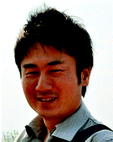DOI: 10.1039/C4CC90104E
(Profile)
Chem. Commun., 2014, 50, 4774-4775
Interview with Tomoki Ogoshi
|
Tomoki Ogoshi received his BS (2000), MS (2002), and PhD degrees (2005) from Kyoto University under the supervision of Prof. Yoshiki Chujo. He received JSPS research fellowships for young scientists (2002–2005). He was a JSPS postdoctoral research fellow (2005–2006) in the Graduate School of Science at Osaka University in the group of Prof. Akira Harada. In 2006, he moved to the Graduate School of Natural Science and Technology at Kanazawa University as an assistant professor and was promoted to an associate professor in 2010. He works as JST-PRESTO Researcher: PRESTO program “Hyper-nano-space design toward innovative functionality” from October 2013. He has received an Award for Encouragement of Research in Polymer Science; The Society of Polymer Science, Japan (2010), Young Scientist Lecture Award in The 56th Polymer Research Symposium (Kobe) (2010), HGCS Japan Award Excellence 2010 (2011), The Chemical Society of Japan Award for Young Chemists (2012), and The Cram Lehn Pedersen Prize in Supramolecular Chemistry; Royal Society of Chemistry (2013). His research interests include organic synthesis, and supramolecular and hybrid materials. |
Do you remember what it felt like to publish your first ChemComm article?
Yes. My first ChemComm paper was published in 2006 (DOI: 10.1039/B605804C). At the time, I was a postdoctoral fellow at Osaka University in the groups of Prof. Akira Harada. The paper was related to the synthesis of a cyclodextrin-grafted π-conjugated polymer. I started the work after joining his laboratory, but the synthesis of the new polymer needed many reaction steps and effort. Thus, I was very happy and excited the paper was accepted in ChemComm. This work was a starting point for me in the field of supramolecular chemistry.How has your research evolved from your first to your most recent article?
When I was a postdoctoral fellow and an assistant professor, I used cyclodextrins for construction of various supramolecular assemblies. I like cyclodextrins because they have many advantages such as commercial availability, high water-solubility and biocompatibility. However, cyclodextrins also have disadvantages: solubility of cyclodextrins in organic solvents is low and yields of functionalized cyclodextrins are very low. Thus, I'd like to synthesize new macrocyclic compounds which overcome these disadvantages. This is my motivation for targeting synthesis of new macrocyclic hosts, and led to our recent works using new hosts pillar[n]arenes.What do you like most about publishing in ChemComm?
The reviewing process is very quick to publication. Free publishing in colour is also a very good point.What aspect of your research are you most excited about at the moment?
Our recent work focus on the supramolecular chemistry using our new macrocyclic hosts pillar[n]arenes. I believe that pillar[n]arenes should have many advantages compared with traditional host molecules such as ease of synthesis, high functionality, superior host–guest properties and planar chirality. We can find new advantages, which cannot be accomplished with other macrocyclic hosts. I am really excited at the moment.What is the best part of your job?
Discussion about research subjects with my colleagues and students is the best part of my job. If we can get a new interesting research subject arising out of the discussion, I'm very excited and I like to know the results as soon as possible.What is the secret to success in scientific publishing?
The most important point is trying original subjects, which other researchers haven’t thought of. Working hard is also very important. I believe these lead to developing new ideas and unexpected spin off discoveries.What is your advice to young emerging scientists?
I'm also young, so it is difficult for me. But, when you have a chance to join new laboratory and project team, it is very good chance for you to find new interests. When I joined the current laboratory as an assistant professor, one of the projects in our laboratory was the synthesis of phenolic resins. Thus, I also tried to synthesize new phenolic resins. This led to the discovery of new macrocyclic hosts pillar[n]arenes. The combination of your background with the ideas in the laboratory and project team is one of the good chances to find a subject that can very much excite you and other people.What do you do in your spare time?
I spend my spare time with my wife and daughter. Especially, taking a bath with my wife and daughter is a very fun and relaxing time for me.By the time I'm 100 I would like to have…
have continued research and published a thousand papers as a first author.| This journal is © The Royal Society of Chemistry 2014 |

